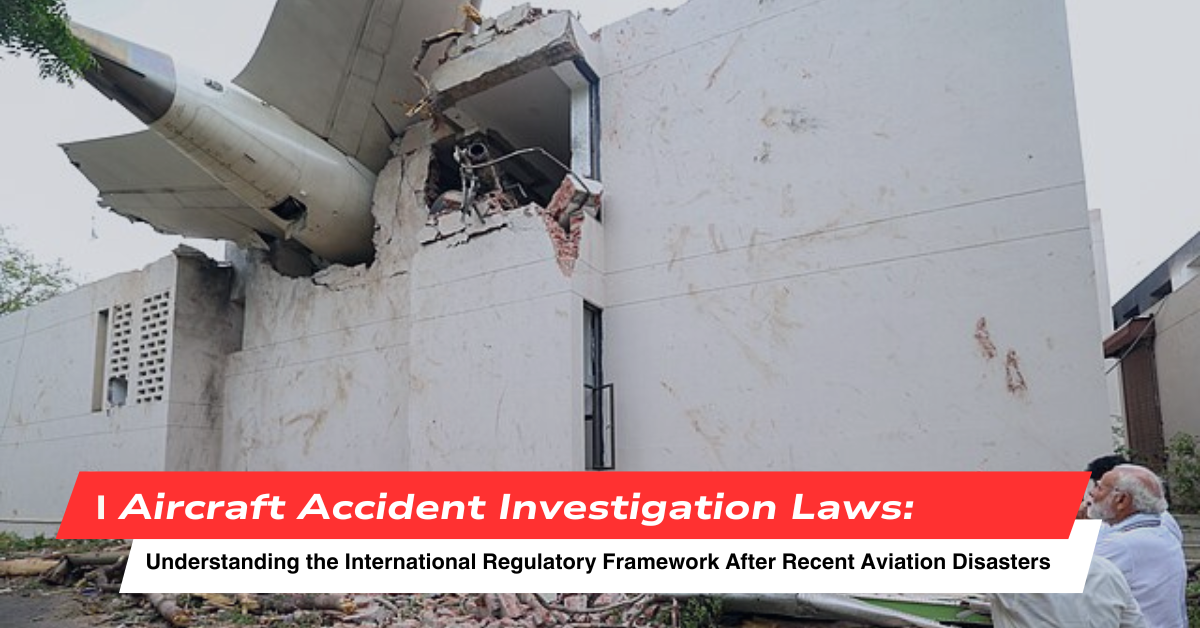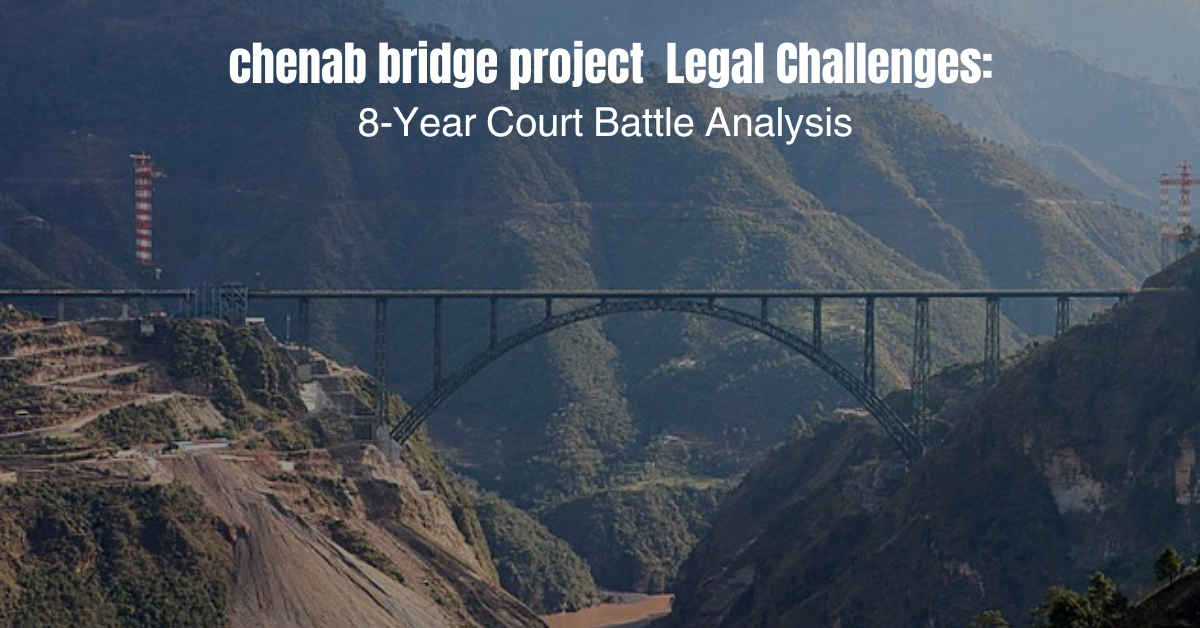Executive Summary
The tragic Air India flight AI171 crash in Ahmedabad on June 12, 2025, which claimed over 240 lives, has once again highlighted the critical importance of robust aircraft accident investigation frameworks and liability provisions[1][2]. This comprehensive analysis examines the legal provisions governing aircraft crashes and investigations, exploring both the immediate incident and the broader international regulatory architecture that governs aviation safety worldwide.

The Ahmedabad Plane Crash Incident: A Brief Overview
Flight Details and Tragedy
On June 12, 2025, Air India flight AI171, a Boeing 787-8 Dreamliner carrying 242 passengers and crew members, crashed shortly after takeoff from Ahmedabad Airport while en route to London’s Gatwick Airport[1][2]. The aircraft, with registration number VT-ANB, was airborne for approximately 32 seconds before crashing into a medical college hostel building[1][3]. The passenger manifest included 169 Indian nationals, 43 British citizens, seven Portuguese nationals, and one Canadian[1].
Immediate Response and Investigation
Following the crash, multiple investigation agencies were activated in accordance with international protocols[4]. The Aircraft Accident Investigation Bureau (AAIB) of India took primary responsibility for the investigation, while the United States National Transportation Safety Board (NTSB) and UK’s Air Accidents Investigation Branch joined the probe due to their respective interests as the state of aircraft manufacture and operator involvement[4].
International Legal Framework for Aircraft Accident Investigation
The Chicago Convention Foundation
The cornerstone of international aviation law is the Chicago Convention of 1944, formally known as the Convention on International Civil Aviation[5][6]. Article 26 of the Convention establishes the fundamental principle that the state where an aircraft accident occurs has primary responsibility for conducting the investigation[5][6]. This provision ensures that investigations are conducted systematically and that findings are shared internationally to enhance global aviation safety.
ICAO Annex 13: The Investigation Blueprint
The International Civil Aviation Organization (ICAO) Annex 13 provides the detailed framework for aircraft accident and incident investigation[6][7]. This critical document establishes several key principles:
Primary Objectives
The sole objective of aircraft accident investigation is the prevention of future accidents and incidents, explicitly stating that investigations are not conducted to apportion blame or liability[6][8]. This “no-blame” principle encourages cooperation and transparency in the investigation process.
State Responsibilities
Under Annex 13, multiple states may participate in investigations based on their connection to the aircraft or incident[4][8]:
- State of Occurrence: The country where the accident occurs leads the investigation
- State of Registry: The country where the aircraft is registered
- State of the Operator: The country of the airline operating the aircraft
- State of Design: The country where the aircraft was designed
- State of Manufacture: The country where the aircraft or its components were manufactured
Investigation Timeline and Reporting
States conducting investigations must submit a Preliminary Report to ICAO within thirty days of the accident[9]. The Final Report must be made publicly available within twelve months, or interim statements must be provided on each anniversary if the investigation extends beyond this timeframe[9].
Investigation Authority Structure
Independence Requirements
Annex 13 mandates that accident investigation authorities must be independent from state aviation authorities and other entities that could interfere with the investigation’s conduct or objectivity[10][8]. This independence is crucial for maintaining the integrity and credibility of the investigation process.
Investigator-in-Charge Powers
The investigator-in-charge has unrestricted authority over the investigation’s conduct and must have access to all relevant evidence without seeking prior consent from judicial bodies or other government authorities[11][10].
Liability and Compensation Framework
The Montreal Convention System
The Montreal Convention of 1999 represents the most significant international agreement governing airline liability for passenger death and injury[12][13]. India ratified this convention in 2009, making it applicable to the recent Ahmedabad incident[14][3].
Two-Tier Liability Structure
The Montreal Convention establishes a two-tier compensation system[12][13]:
- Strict Liability Tier: Airlines are strictly liable for proven damages up to 128,821 Special Drawing Rights (SDR), approximately $175,000 USD[12][14]
- Negligence-Based Tier: For damages exceeding the strict liability limit, airlines can only avoid liability by proving the accident was not due to their negligence or was caused solely by third-party negligence[12][13]
Recent Liability Limit Updates
The International Civil Aviation Organization announced increases to Montreal Convention liability limits effective December 28, 2024[14]. The upper limit for death compensation increased to 151,880 SDR from 128,821 SDR, translating to approximately ₹1.8 crore for flights to or from India[14].
Domestic Legal Framework in India
Aircraft Act 1934 and Rules
India’s domestic aviation accident investigation framework is governed by the Aircraft Act 1934 and subsequent rules[15][11]. The Aircraft (Investigation of Accidents and Incidents) Rules 2012, amended in 2017 and 2021, establish the AAIB as an independent investigation authority[11][16].
Strict Liability Principles
Indian aviation law follows strict liability principles for aircraft-caused surface damage, meaning operators are liable regardless of fault or negligence[15]. This approach ensures victims receive compensation without needing to prove wrongdoing by the aircraft operator.
Investigation Procedures and Best Practices
Evidence Collection and Preservation
Modern aircraft accident investigations follow systematic procedures for evidence collection and analysis[17][18]:
On-Scene Investigation
- Immediate site security and preservation
- Systematic photography and documentation
- Witness statement collection
- Wreckage examination and mapping
- Flight data recorder and cockpit voice recorder recovery
Technical Analysis
- Flight data analysis
- Maintenance record examination
- Crew training and certification review
- Weather and environmental factor assessment
- Aircraft system functionality evaluation
International Cooperation Protocols
Multi-State Participation
The complexity of modern aviation often requires international cooperation in accident investigations[4][8]. States with legitimate interests in the investigation are entitled to participate and contribute expertise to the process.
Information Sharing
Investigation findings and safety recommendations are shared internationally through ICAO to prevent similar accidents worldwide[6][9]. This collaborative approach has significantly contributed to aviation safety improvements over decades.
Regulatory Bodies and Their Roles
Global Organizations
International Civil Aviation Organization (ICAO)
ICAO sets global standards and recommended practices for aviation safety and accident investigation[6][7]. The organization’s Annex 13 provides the universal framework followed by member states.
Regional Investigation Organizations
ICAO encourages the establishment of regional accident investigation organizations to enhance cooperation and resource sharing among neighboring states[10].
National Authorities
Aircraft Accident Investigation Bureau (India)
Established in 2012 as an independent entity under the Ministry of Civil Aviation, the AAIB conducts investigations in accordance with ICAO standards while maintaining operational independence from regulatory authorities[11].
National Transportation Safety Board (United States)
The NTSB serves as a model for independent accident investigation, with authority to investigate accidents involving U.S.-manufactured aircraft worldwide[18].
Emerging Legal Challenges and Considerations
Technological Advancement Impact
Modern aircraft systems present new challenges for investigators and legal frameworks[19]. The increasing complexity of automated systems requires specialized expertise and may necessitate updates to existing legal structures.
Cybersecurity Concerns
As aircraft systems become more connected, cybersecurity incidents may require new investigation approaches and legal considerations not fully addressed in current frameworks.
Unmanned Aircraft Systems
The growing use of drones and unmanned aircraft systems creates new categories of incidents that may require specialized investigation procedures and liability frameworks.
Recommendations for Legal Practitioners
Immediate Response Protocols
Law firms representing aviation stakeholders should establish clear protocols for immediate response to aircraft accidents, including:
- Coordination with investigation authorities
- Evidence preservation procedures
- Client communication strategies
- Insurance notification requirements
Regulatory Compliance
Legal practitioners must stay current with evolving international and domestic regulations governing aircraft accident investigation and liability to provide effective representation.
Cross-Border Coordination
Given the international nature of aviation, legal teams should be prepared to coordinate with foreign counterparts and navigate multiple legal jurisdictions.
Conclusion
The legal framework governing aircraft accident investigation and liability represents a complex intersection of international treaties, domestic legislation, and industry best practices. The recent Air India crash in Ahmedabad demonstrates the importance of robust investigation procedures and clear liability provisions in ensuring justice for victims while promoting aviation safety improvements.
As the aviation industry continues to evolve with new technologies and operational models, the legal framework must adapt to address emerging challenges while maintaining the fundamental principles of thorough investigation and fair compensation. Legal practitioners in the aviation sector must remain vigilant in understanding these evolving frameworks to effectively serve their clients and contribute to the broader goal of aviation safety enhancement.
The tragedy in Ahmedabad serves as a stark reminder that while aviation remains statistically the safest form of transportation, the consequences of accidents are severe, making robust legal frameworks essential for both prevention and response. Through continued international cooperation and legal framework evolution, the aviation industry can work toward the ultimate goal of preventing such tragedies while ensuring appropriate support for those affected when accidents do occur.
Citations:
[1] Air India Dreamliner crashes into Ahmedabad college hostel, kills over 240 https://www.reuters.com/world/india/plane-crashes-indias-ahmedabad-airport-tv-channels-report-2025-06-12/
[2] Plane Crash news – Today’s latest updates https://www.cbsnews.com/tag/plane-crash/
[3] Air accident compensation: The economics of an unfortunate loss https://www.barandbench.com/columns/air-accident-compensations-the-economics-of-an-unfortunate-loss
[4] Why US Investigators Are Probing an Air India Crash on Indian Soil https://vajiramandravi.com/current-affairs/why-us-investigators-are-probing-an-air-india-crash-on-indian-soil/
[5] [PDF] International aircraft accidents: the international legal framework http://www.drysdalehydroponics.co.nz/uploads/88397/files/International_Aircraft_Accidents_-_the_international_legal_framework.pdf [6] Annex 13 – Aircraft Accident and Incident Investigation – ICAO https://applications.icao.int/postalhistory/annex_13_aircraft_accident_and_incident_investigation.htm
[7] [PDF] Annex 13 – Foundation for Aviation Competence (FFAC) https://ffac.ch/wp-content/uploads/2020/10/ICAO-Annex-13-Aircraft-Accident-and-Incident-Investigation.pdf
[8] Introduction to Accident Investigation | SKYbrary Aviation Safety https://skybrary.aero/articles/introduction-accident-investigation
[9] Frequently Asked Questions – ICAO https://www.icao.int/about-icao/FAQ/Pages/icao-frequently-asked-questions-faq-11.aspx
[10] [PDF] Manual of Aircraft Accident and Incident Investigation – SKYbrary https://skybrary.aero/sites/default/files/bookshelf/3282.pdf [11] Aircraft Accident Investigation Bureau – Ministry of Civil Aviation https://www.civilaviation.gov.in/node/4095
[12] Montreal Convention – Wikipedia https://en.wikipedia.org/wiki/Montreal_Convention
[13] International Conventions For Aviation Accidents – Irwin Mitchell https://www.irwinmitchell.com/personal/personal-injury-compensation/air-rail-and-sea-related-claims/air-accident-claims/international-conventions-for-aviation-accidents
[14] Are Airlines Liable To Pay Compensation After Flight Crash In India? https://www.ndtvprofit.com/trending/are-airlines-liable-to-pay-compensation-after-flight-crash-in-india
[15] Strict liability for aircraft-caused surface damage: airplane crashes or … https://blog.ipleaders.in/strict-liability-for-aircraft-caused-surface-damage/
[16] [PDF] Aircraft (Investigation of Accidents and Incidents) Rules, 2012 https://www.civilaviation.gov.in/sites/default/files/migration/moca_003427.pdf
[17] [PDF] AIG – Process for investigating the various types of accidents – ICAO https://www.icao.int/NACC/Documents/eDOCS/AIG/01-AIGProceduresWebinar03-EN-P01.pdf
[18] The Investigative Process – NTSB https://www.ntsb.gov/investigations/process/Pages/default.aspx
[19] Boeing 737 MAX 8 Crash | Aviation Accident Lawsuit Updates https://www.beasleyallen.com/aviation-accidents/boeing-737-max-8-crashes/













